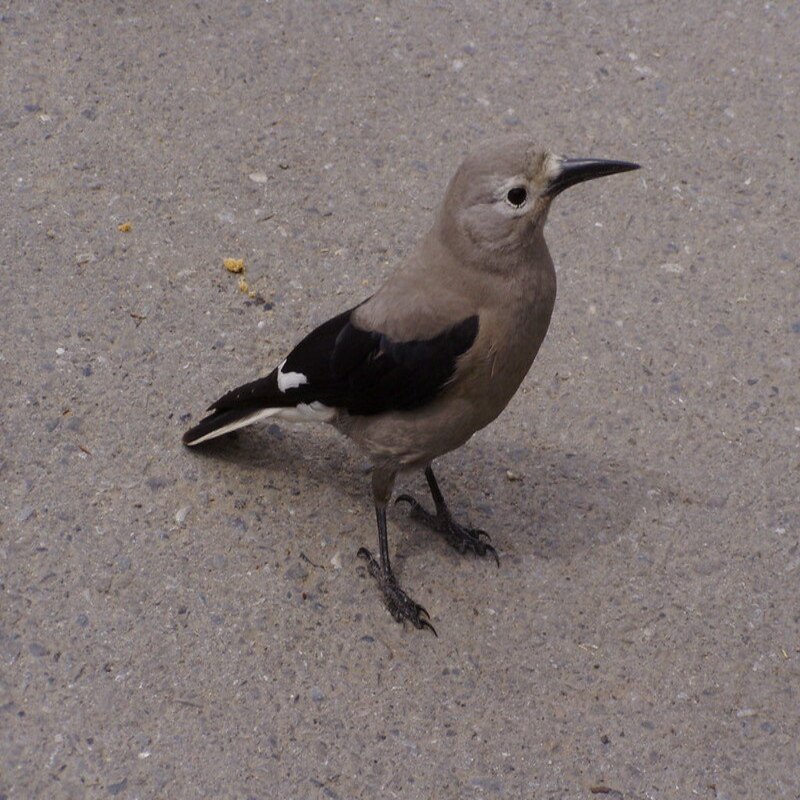Clark’s nutcracker, Nucifraga columbiana, sometimes known as Clark’s crow or woodpecker crow, is a passerine bird in the Corvidae family endemic to western North America’s Rockies. The nutcracker is an omnivore, but subsists mostly on pine nuts, which it burys in the summer and then retrieves by memory in the winter.
Quick Overview: Nucifraga Columbiana – Clark’s Nutcracker
Body size: Around 12.5 in (32 cm) and a weight of 142 g (5 oz)
Main colors: Gray, Black, White
Range: Northwestern United States
Migratory Bird: No
Best time of the year to see in the U.S.: All Year (January – December)
Conservation Status: Least Concern
Clark’s Nutcracker Description
Clark’s nutcracker is a large, jay-sized bird. It has a powder-gray plumage with a loose feel. Glossy black feathers cover the wings and middle tail feathers. When folded, the wings extend nearly to the tip of the tail. Flight is crow-like, with deep wing beats, and white wing patches and outside retricies may be observed during flight. There is a little size difference between the sexes, with males being larger.

Size
These birds have a length of 12.5 in (32 cm) and a weight of 142 g (5 oz). Their wings could range from 18 in (46 cm).
Feeding
Though conifer seeds comprise the majority of this nutcracker’s diet, it will graze on other food sources as needed. Additionally, flying insects and ants, tiny vertebrates, eggs and nestlings, and even carrion are included in their meals. Their powerful pointed bills are used to remove seeds off unripe cones or to hammer and smash seeds in their shells. They will then either consume the seeds or store them in their sublingual pouches for later caching.
Habitat
In the summer, it favors habitat near the tree line in the sub-alpine zone. Semi-open, mixed forests of pine, fir, and spruce on steep slopes and ridges interspersed with meadows and streams are the preferred habitat. The tree species found within the ecosystem vary geographically. As long as the food is available, Nutcrackers will remain on their summer range. They travel to lower elevations in the winter, where they spend the winter foraging and recovering caches.
Behavior
Behavior is immediately distinguishable and recognisable. Long-distance flying is powerful and precise. When flying between trees, the flight pattern is similar to that of a woodpecker, with flapping and gliding. It bounces around the ground, tilting its head from side to side as it gathers seeds. Clark’s nutcrackers, like other members of the Corvidae family, are exceedingly clever. Their highly developed spatial memory has been studied in relation to their food hoarding and retrieval skills.
Nucifraga Columbiana Scientific Classification
- Kingdom: Animalia
- Phylum: Chordata
- Subphylum: Chelicerata
- Class: Aves
- Order: Passeriformes
- Family: Corvidae
- Genus: Nucifraga
- Species: Nucifraga columbiana
Other common names
It is also known as Clark’s crow or woodpecker crow.
Best time of the year to see
In the United States, the best time of year to see these birds is all year round, regardless of the season. This refers to any month of the year between January and December.
Distribution of the Clark’s Nutcracker in the USA
From northern British Columbia and western Alberta to southern California and New Mexico, this species is a resident. Additionally, it has been observed occasionally in northeastern Mexico. During the winter, it may go as far east as Saskatchewan and as far south as Texas.
The Clark’s Nutcracker can be found in the following states in the United States – Montana, Oregon, Washington, Idaho, Nevada, Utah, Colorado, and Wyoming.
